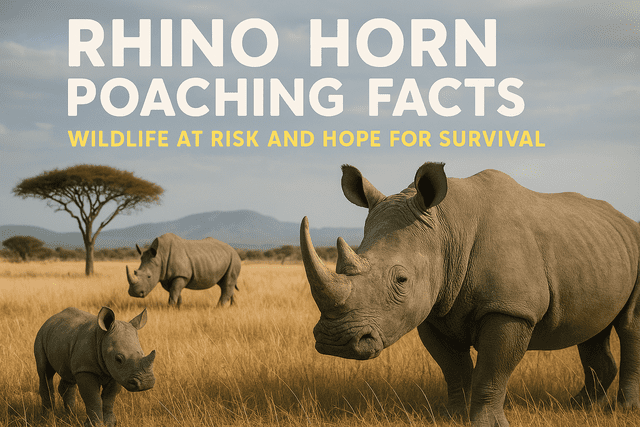
Rhino Horn Poaching Facts: Wildlife at Risk and Hope for Survival
Table of Content
- 1 Poaching: A Global Crisis Threatening Wildlife
- 2 Why Do Animals Become Targets of Poaching?
- 3 Is Poaching Rhinos a Real Problem?
- 4 How Many Wild Rhinos Are Left?
- 5 Why Are Rhinos Popular Targets?
- 6 The Ripple Effect of Rhino Poaching
- 7 Hope for the Future
- 8 Conclusion
- 9 FAQs About Poaching and Rhinos
- 9.1 What is poaching?
- 9.2 How is poaching different from legal hunting?
- 9.3 Why is poaching considered a global issue?
- 9.4 Which animals are most affected by poaching?
- 9.5 How many species go extinct each year due to poaching?
- 9.6 Why are rhinos especially targeted by poachers?
- 9.7 How many rhinos are left in the wild today?
- 9.8 How often is a rhino poached?
- 9.9 What are the main species of rhinos still alive?
- 9.10 How has poaching affected rhino populations over time?
- 9.11 Do rhino horns have real medicinal benefits?
- 9.12 Why is rhino horn so expensive?
- 9.13 How does poaching affect ecosystems?
- 9.14 Which countries are most affected by rhino poaching?
- 9.15 What are governments doing to stop poaching?
- 9.16 How are conservation organizations helping rhinos?
- 9.17 Has there been any success in reducing rhino poaching?
- 9.18 What role do local communities play in fighting poaching?
- 9.19 How can individuals help stop poaching?
- 9.20 What will happen if poaching is not stopped?
- 9.21 Related Posts
Poaching: A Global Crisis Threatening Wildlife
Poaching is a worldwide problem that threatens some of the planet’s most iconic and irreplaceable species. It is more than just a challenge faced by a handful of animals or certain countries, it’s a global crisis.
This brutal act of aggression against nature takes place across continents, from Africa’s savannas to Asia’s dense jungles, even stretching into oceans and forests worldwide. While some nations enforce stricter laws and stronger protections, poaching remains deeply ingrained in many societies, often fueled by poverty, weak enforcement, corruption, and the lure of high profits on the black market.
When most people think of poaching, elephants, tigers, gorillas, and rhinos often come to mind. These are indeed among the most tragically affected animals. However, poaching is not limited to just these species.
Countless others, from pangolins, sea turtles, and exotic birds to lesser-known amphibians—face constant danger. Scientists estimate that nearly 30,000 species go extinct each year, with habitat destruction and climate change playing a role, but poaching is a major contributor to this alarming rate.
Why Do Animals Become Targets of Poaching?
Poaching is defined as the illegal killing, trapping, or trafficking of wildlife, and it is very different from regulated hunting. Legal hunting, when managed responsibly, can contribute to conservation efforts and help balance ecosystems. Poaching, however, strips nature of its balance, offering no ecological benefit.
When species are targeted relentlessly, the consequences ripple far beyond their populations. Removing even one key predator or prey animal from the natural food chain can destabilize ecosystems. For example:
- If top predators like tigers vanish, prey species such as deer may multiply unchecked, leading to overgrazing and habitat collapse.
- The disappearance of elephants, known as “ecosystem engineers,” would alter landscapes dramatically, impacting plant and animal diversity.
Biodiversity is essential. Each species plays a unique role, and when poaching drives them toward extinction, the entire natural world suffers.
Is Poaching Rhinos a Real Problem?
Among the world’s most iconic creatures, rhinos have become one of the most endangered victims of poaching. Once abundant across Europe, Africa, and Asia, their numbers have plummeted due to relentless hunting and habitat destruction. Today, most wild rhinos survive only in tightly protected conservation areas.
How Many Wild Rhinos Are Left?
The statistics paint a grim picture:
- Fewer than 30,000 rhinos are alive worldwide.
- On average, one rhino is killed every 12 hours for its horn.
- Black rhinos have lost more than 97% of their population since the 1960s.
- The Javan and Sumatran rhinos are critically endangered, with fewer than 100 individuals of each species left alive today.
Where once multiple rhino species roamed freely, only five species remain, and two are teetering on the brink of extinction.
Why Are Rhinos Popular Targets?
The primary reason rhinos are so heavily poached is their horn, which is more valuable than gold on the black market. Rhino horn is sought after for several reasons:
- Cultural Symbolism: In some Asian cultures, rhino horn is a symbol of wealth, power, and social status.
- Traditional Medicine: For centuries, ground rhino horn has been falsely believed to treat fevers, pain, and even life-threatening illnesses, despite scientific evidence disproving its medical benefits.
- Luxury Demand: The rarity of rhino horn makes it an elite product for display and status, fueling demand among wealthy buyers.
This deadly demand has driven rhinos to the edge of extinction, erasing genetic diversity and threatening the survival of future generations.
The Ripple Effect of Rhino Poaching
Rhino poaching does not just impact rhinos—it harms entire ecosystems. Rhinos are “mega-herbivores” that help shape landscapes by grazing, which allows plants to regenerate and creates open spaces for other species to thrive. Losing them would mean losing a critical balance in their ecosystems.
Hope for the Future
Despite the grim statistics, there is hope. Conservation groups, governments, and local communities are working tirelessly to protect rhinos and other endangered species. Measures include:
- Stronger anti-poaching laws and penalties for traffickers.
- Armed patrols and modern surveillance technologies like drones and GPS tracking.
- Breeding programs to rebuild populations in sanctuaries.
- Community engagement, offering locals sustainable alternatives to poaching.
The fight is far from over, but awareness and action can make a difference. Supporting conservation organizations, spreading awareness, and rejecting products made from endangered species are steps everyone can take.
If global cooperation continues and demand for illegal wildlife products decreases, there’s still a chance to ensure that future generations will live in a world where rhinos, elephants, tigers, and thousands of other species still roam free.
Conclusion
Poaching is not just a crime against wildlife—it is a direct threat to the balance of nature and the survival of future generations. From rhinos and elephants to countless lesser-known species, the relentless demand for animal parts has pushed biodiversity to the brink.
While the statistics may seem grim, there is still hope. With stronger laws, global cooperation, community involvement, and increased awareness, we can turn the tide against poaching.
Every individual has a role to play, whether through education, advocacy, or supporting conservation efforts. Protecting endangered species like rhinos is more than just saving animals, it’s about safeguarding ecosystems, preserving cultural heritage, and ensuring that our planet remains vibrant and diverse for centuries to come.
FAQs About Poaching and Rhinos
What is poaching?
Poaching is the illegal hunting, capturing, or killing of wildlife, usually for profit, without regard for conservation laws or regulations.
How is poaching different from legal hunting?
Legal hunting is regulated, often helps fund conservation, and follows strict guidelines. Poaching, on the other hand, is unregulated, destructive, and illegal.
Why is poaching considered a global issue?
Poaching occurs across every continent, threatening biodiversity, disrupting ecosystems, and driving countless species toward extinction.
Which animals are most affected by poaching?
Elephants, rhinos, tigers, gorillas, pangolins, and sea turtles are among the most heavily poached animals, but thousands of lesser-known species are also targeted.
How many species go extinct each year due to poaching?
Scientists estimate around 30,000 species go extinct annually, with poaching being one of the leading causes alongside habitat destruction and climate change.
Why are rhinos especially targeted by poachers?
Rhinos are poached for their horns, which are falsely believed to have medicinal properties and are also used as luxury status symbols.
How many rhinos are left in the wild today?
Fewer than 30,000 rhinos remain worldwide, with some subspecies, like the Javan and Sumatran rhinos, having fewer than 100 individuals left.
How often is a rhino poached?
On average, one rhino is killed every 12 hours for its horn.
What are the main species of rhinos still alive?
There are five remaining species: White rhino, Black rhino, Indian (Greater One-horned) rhino, Javan rhino, and Sumatran rhino.
How has poaching affected rhino populations over time?
For example, black rhinos have lost more than 97% of their population since the 1960s due to poaching and habitat loss.
Do rhino horns have real medicinal benefits?
No. Scientific research has proven that rhino horns are made of keratin, the same substance found in human hair and nails, and they have no proven medical value.
Why is rhino horn so expensive?
Its rarity and cultural demand make it one of the most valuable items on the black market, sometimes more expensive than gold or diamonds.
How does poaching affect ecosystems?
Poaching disrupts natural food chains, reduces biodiversity, and destabilizes entire ecosystems. For example, removing elephants or rhinos changes landscapes dramatically.
Which countries are most affected by rhino poaching?
South Africa, Namibia, and other African nations are most heavily impacted, though poaching also occurs in Asia.
What are governments doing to stop poaching?
Governments enforce stricter anti-poaching laws, deploy armed patrols, use drones and surveillance technologies, and collaborate internationally to stop trafficking.
How are conservation organizations helping rhinos?
They run breeding programs, establish sanctuaries, educate local communities, and fund anti-poaching patrols to protect remaining rhino populations.
Has there been any success in reducing rhino poaching?
Yes. Countries like Nepal have celebrated “zero poaching” years, and white rhino numbers have increased in certain reserves due to strong protection.
What role do local communities play in fighting poaching?
Engaging local communities with jobs in ecotourism and conservation reduces reliance on poaching and builds long-term protection for wildlife.
How can individuals help stop poaching?
People can donate to conservation groups, spread awareness, avoid buying wildlife products, and support sustainable tourism.
What will happen if poaching is not stopped?
If left unchecked, poaching could push many species, including rhinos, into extinction, leading to severe ecological imbalances and a permanent loss of biodiversity.


